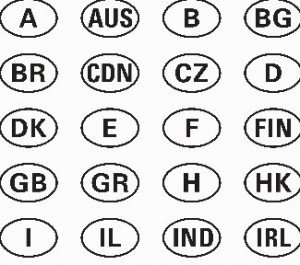


Driving your own vehicle abroad
Many drivers abroad opt to take their own vehicle, rather than rent a car in the countries they’re visiting. This is especially true of drivers of motor homes who may choose to take an extended tour of a number of countries for a lengthy period of time, which would make renting a car in each country very expensive.
There are different rules in force depending on –
a)Your home country
b) Which country(s) you want to drive your own vehicle in
It may be that you can be legally covered to the minimum level required by law in another country, via the International Motor Insurance Card System. This covers many regions of the world and allows drivers to visit other countries and be covered for 3rd party insurance by holding a valid card.
There a bewildering array of different coloured cards in operation across the world, with all serving much the same purpose – to ensure that the that victims of road traffic accidents do not suffer from the fact that injuries or damage sustained by them were caused by a foreign motorist . Generally, the system is a reciprocal agreement between insurance companies in neighbouring or nearby countries, meaning that if you are a holder of an International Motor Insurance card, you will be covered by at least 3rd party insurance when driving abroad. If you want to extend the full cover of your home policy, you will need to speak to your insurance company, who will levy an additional charge, depending on where you plan to take your vehicle.
There are multiple motor insurance systems around the world, established on regional basis. The first was the Green Card system established in 1949 in Europe, but later other regions followed suit.
Most motor insurers will issue an International Motor Insurance Card to their policy holders, but have no obligation to do so. Even if your company say a green card isn’t needed, it’s useful to have one if your insurance certificate is only written in your own language. Some insurers do print on translations to the principal European languages on the reverse of their certificates, explaining that your certificate is evidence of the existence of the minimum cover required by law throughout the European Union.
Some countries of the world don’t recognise International Motor Insurance Cards at all, and some countries require drivers to have insurance via a local company. You do therefore need to plan for the specific countries you intend to take your vehicle to.
International Motor Insurance Card Systems
The Green Card system
The Green Card system is overseen by the Economic Commission for Europe, based in Geneva and is recognised in over 40 countries including all the countries in Europe and a number of neighbouring states.
It offers no insurance cover. It is proof that the minimum legal requirements for third party liability insurance in any country for which the Green Card is valid are covered by the insured’s own motor policy. If you want to extend the full cover you have on your policy in your own country, you will need to speak to your insurance company –obviously they will charge more for this.
A Green Card is not required by law to cross borders within the European Union and some other countries. This is because all EU countries and certain other countries comply with the first directive on motor insurance, which says that every insurance policy issued in the EU must provide the minimum insurance cover required by law in any other EU country.
Countries covered by the Insurance Green Card are –
Albania
Andorra
Austria
Belarus
Belgium
Bosnia
Bulgaria
Croatia
Cyprus
Czech Republic
Denmark
Estonia
Finland
France
Germany
Greece
Hungary
Iceland
Iran
Ireland
Israel
Italy
Latvia
Lichtenstein
Lithuania
Luxembourg
Macedonia
Malta
Moldova
Montenegro
Morocco
Netherlands
Norway
Poland
Portugal
Romania
Russia
Serbia
Slovakia
Slovenia
Spain
Sweden
Switzerland
Tunisia
Turkey
Ukraine
UK
The EU countries that don’t need a Green Card by law are :
Andorra, Austria, Belgium, Bulgaria, Croatia, Cyprus, Czech Republic, Denmark, Estonia, Finland, France, Germany, Greece, Hungary, Iceland, Ireland, Italy, Latvia, Lithuania, Luxembourg, Malta, Netherlands, Norway, Poland, Portugal, Romania, Slovak Republic, Slovenia, Spain, Sweden, Switzerland, UK
Orange card system
The Orange card system is established between most of the members of the Arab League and is applicable primarily in the Middle East and North Africa.
Participants are: Algeria, Bahrain, Egypt, Iraq, Jordan, Kuwait, Lebanon, Libya, Mauritania, Morocco (also Green card member), Oman, Qatar, Saudi Arabia, Somalia, Sudan, Syria, Tunisia (also Green card member), United Arab Emirates and Yemen.
Blue card system
The Blue card system is established between the members of the ASEAN and is applicable in South East Asia.
Participants are: Brunei, Cambodia, Laos, Malaysia, Myanmar, Indonesia, Philippines, Thailand and Vietnam.
Pink card system
The Pink card system is established between the members of the Economic Community of Central African States and is applicable in Central Africa.
Participants are: Cameroon, Central African Republic, Chad, Congo, Gabon and Equatorial Guinea.
Brown card system
The Brown card system is established between most of the members of the Economic Community of West Africa States and is applicable in Western Africa.
Participants are: Benin, Burkina Faso, Gambia, Ghana, Guinea, Guinea-Bissau, Ivory Coast, Liberia, Mali, Niger, Nigeria, Senegal, Sierra Leone and Togo.
Yellow card system
The Yellow card system is established between most of the members of the Common Market of East Africa States and is applicable primarily in Eastern Africa.
Participants are: Burundi, DR Congo, Eritrea, Ethiopia, Kenya, Malawi, Rwanda, Tanzania, Uganda, Zambia and Zimbabwe.
The non-participating COMESA members are: Comoros, Djibouti, Egypt (Orange card member), Libya (Orange card member), Madagascar, Mauritius, Seychelles, Sudan (Orange card member) and Swaziland.
White card system
This is still at proposal stage and could include the following countries if they are deemed unable to join the green card scheme –
Afghanistan, Azerbaijan (Green card candidate), Kazakhstan, Kyrgyzstan Pakistan, Tajikistan, Turkmenistan ,Uzbekistan
International Car Insurance –
Before you begin your search for an international car insurance policy, you should ask for some international car insurance quotes from your current insurance company. Sometimes a domestic company will offer this type of insurance, or if they don’t, they can give you some advice.
There are also a number of companies who specialise in International motor insurance –
Clements are probably the best known company specialising in policies for ex-pats and others wanting to drive their vehicle abroad. www.clements.com/
GEICO are US Based but have many international offices. They work with international insurance underwriters to find a company who will provide cover in the region you’ll be taking your vehicle to. http://www.geico.com/information/aboutinsurance/overseas/
Esurance are a company who specialise in insurance for US Visitors wanting to take their own vehicle to Canada or Mexico http://www.esurance.com/international-insurance
Carnet de Passage
A Carnet de Passage is a customs document which allows drivers to temporarily import a vehicle into a country. i.e drive through a country.The personal tourist vehicle Carnet system is administered by the Alliance Internationale de Tourisme in Switzerland. The Carnet document shows Customs officials that the vehicle owner has posted a bond at least equal to the vehicle import duty of their country, and assures that the vehicle will be re-exported to its country of origin. The Automobile Associations of most countries can also arrange a CDP for vehicles registered in their country.
The following countries require a Carnet de Passage to temporarily import a vehicle (though be aware that rules change often so before planning a trip, get definitive advice from the embassies of the countries you plan to travel through)-
Africa
Burundi
Cameroon
Central African Republic
Chad
Democratic Republic of the Congo
Djibouti
Egypt
Ethiopia
Ghana
Guinea-Bissau
Kenya
Lesotho
Libya
Nigeria
Rwanda
Senegal
Sudan
Swaziland
Uganda
Asia / Middle East
Bangladesh
India
Iran
Japan
Jordan
Kuwait
Nepal
Oman
Pakistan
Qatar
Singapore (except for Peninsular Malaysia-registered and Thai registered vehicles)
Sri Lanka
Syria
United Arab Emirates
Oceania
Australia
Indonesia
New Zealand
South America
Argentina
Bolivia
Chile
Colombia
Ecuador
Paraguay
Peru
Venezuela
Get your car ready to drive abroad –
Unlike renting a car, where the rental company will ensure your vehicle is equipped to drive in that region, you will need to take responsibility for this yourself and check out the legal requirements and any other considerations of driving in the country you’ll be visiting. This may include –
An international code sticker denoting the country your car is registered in.
Adjustments relating to driving on the wrong side of the road if that applies- eg adjusting the beam of your headlights so as not to dazzle oncoming drivers and fitting additional or changing existing mirror positions.
Ensuring you carry everything you need legally – in many countries you need to carry a red warning triangle and high visibility vests for all passengers. In France you also need to carry a breathalyser.
In many European countries its illegal to carry speed camera detection devices.
Snow tyres are compulsory in some countries in winter.
Some other points to consider –
Risk protection coverage is advisable in certain countries. This is for unusual incidents that can arise out of the level of lawlessness in certain countries. If you will be in one of these more dangerous countries it is advisable for you to purchase additional auto-related policies in case of things like kidnapping or extortion.Also, you will notice that many international car insurance policies have a provision for something called a “standard war exclusion”. This means that in case of war, the insurance provider can withhold payment to you.
Some policies will only cover your vehicle whilst you’re also in the country. Therefore if you take your car abroad, for instance for work, then fly home for a visit, leaving your car abroad, you should check it will be covered for the period you’re in a different country.
Check that your policy includes add-on coverage such as cover for towing and recovery as some won’t.
Check small print when selecting an international policy. Some policies, and some countries, require local adjusters/assessors if they have no agreement with local insurance companies and this can incur additional time and cost to settle a claim.
Ensure you have medical cover and that your policy includes cover for third party claims against you. In some countries its the law that accident victims are compensated and if you’re unable to fund this you could find yourself imprisoned until compensation is paid.
Ensure your policy protects you against currency fluctuations in countries which have volatile currencies.
Finally, if you’re considering an extended trip to more remote parts of the globe, you should think about how easy it will be to get your vehicle repaired if it breaks down or is involved in an accident. Mechanics in the developing world are ingenious with older vehicles and can usually get an old banger back on the road. Faced with a modern vehicle with computerised operating systems and diagnostics, they’re likely to be left scratching their heads. Check out whether spare parts are likely to be readily available for your vehicle too. Try a main dealer for your vehicle manufacturer and ask them if they have distribution networks in the area you’ll be visiting.

2 comments